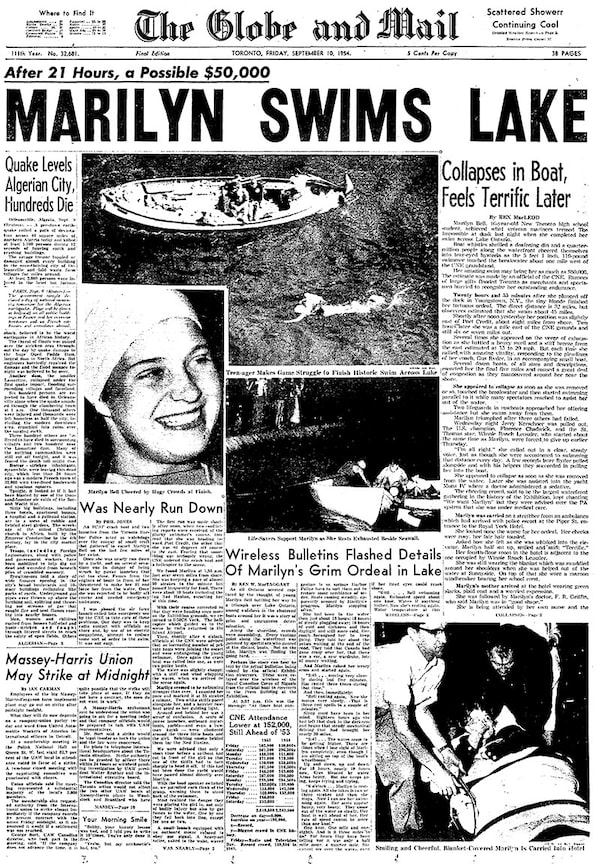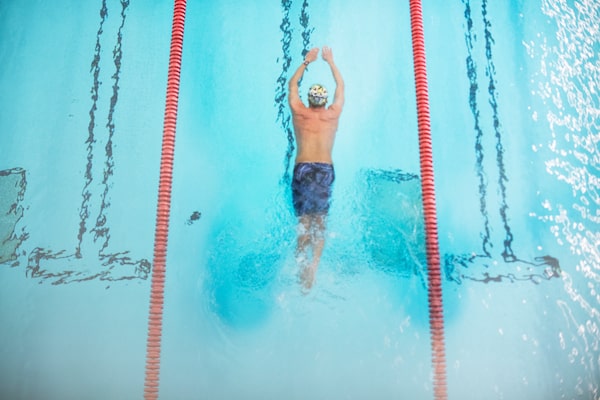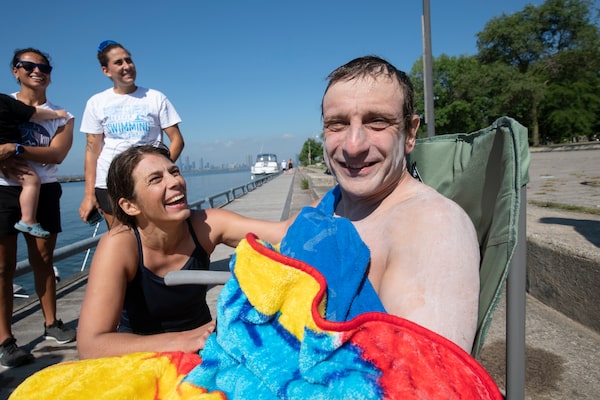Greg Maitinsky, a 46-year-old father of two from Hamilton, is swimming across Lake Ontario. It is just before 4 a.m. on Saturday, Aug. 6. He has already been in the water for nearly 10 hours. The view to the south is total darkness. To the north, Toronto is a thin bead of lights 19 kilometres away. If he can finish, his will be only the 69th completed crossing of the Great Lake since 16-year-old Marilyn Bell was the first to do it in 1954.
Ahead of Mr. Maitinsky, a 42-foot boat carrying supplies is guiding the way using a GPS system. To his left there is a small Zodiac – an inflatable boat – carrying his wife, Cintia, as well as his coach, Lee Hart, and friend Loren King. Marilyn Korzekwa is also with them in the role of swim master – an official who is present to ensure safety and that the rules of the crossing are followed. Another Zodiac ferries between Mr. Maitinsky and the main boat, delivering food and water. Mr. Maitinsky, his slight frame gliding through the water, can be seen thanks to small lights attached to his swim cap and bathing suit.
An hour ago, Mr. Maitinsky was on pace to break the record time of 14 hours and 42 minutes. Now, he’s struggling. His arms and legs are cramping. He’s been shivering for hours. Before the race is over his support team will have to call an ambulance to greet them at the shore.
Christine Arsenault, the captain of the main boat, watches Mr. Maitinsky closely as he drifts away from the navigational line on her GPS system.
“If he doesn’t get back on course he won’t make it,” she yells over the radio to Ms. Korzekwa.
The Zodiac nudges Mr. Maitinsky back on line.
:format(jpeg)/cloudfront-us-east-1.images.arcpublishing.com/tgam/GRUU4HPU6FBBTL462KYYVINBBI.JPG)
:format(jpeg)/cloudfront-us-east-1.images.arcpublishing.com/tgam/7DSHUEE5VRCGHOARHTZERJ5LNI.JPG)
:format(jpeg)/cloudfront-us-east-1.images.arcpublishing.com/tgam/6V3KKSX65JD7FLI4B2RPZ6NV3M.JPG)

The first to swim across Lake Ontario was Marilyn Bell in 1954.
Lake Ontario is one of the world’s most difficult marathon swims, defined as a non-stop swim in open water for at least 10 kilometres. It is not as storied as the English Channel swim, and certainly not as trafficked – 2,400 people have completed solo crossings of its 30-kilometres. But Lake Ontario’s distance – 51 kilometres from Niagara-on-the-Lake to Marilyn Bell Park in Toronto – as well as powerful currents and unpredictable weather, including electrical storms and winds that can churn up 10-foot-high waves, combine to make it a world-class challenge.
Every swimmer has their own reasons for taking it on. For Mr. Maitinsky, who has long lived with bouts of severe anxiety – once suffering a panic attack so intense he was sure he was going to die – it is a part of his continuing mission to not let his condition stop him. He’s also using the attempt to raise money for the Dreamcatcher foundation, in support of its program to provide fresh water for Indigenous communities. And, of course, he’d like to add his name to the history books.
“It’s a beast,” said Ms. Arsenault, who swam the lake in 2011. She reached the shore in 22 hours and 22 minutes, fighting through hours of vomiting.
Yet it is a beast that has been conquered by a wide variety of people. The youngest person to do so was 14 years old, and the oldest was 66. That record time for a one-way crossing was set by Toronto’s John Scott in 1994. The slowest time for a one-way crossing is 41 hours and one minute, set by Kingston’s Jay Serdula in 1998.

Sept. 9, 1974 – the 20-year anniversary of Marilyn Bell's arrival in Toronto – brought bad news about another athlete's attempted crossing of the lake.The Globe and Mail
When Neil MacNeil set out in September of 1974, no official rules governed Great Lake swims, and no organization existed to oversee their safety.
A 17-year-old competitive swimmer from Scarborough, Mr. MacNeil was determined to break the speed record set by 16-year-old Cindy Nicholas earlier that summer of 15 hours and 10 minutes.
Mr. MacNeil left Youngstown, N.Y., on the afternoon of Sept. 7 with only a 12-foot boat for support, much smaller than the 30-foot minimum now required.
Soon after, the boat’s motor broke down. His coach waved him back, but Mr. MacNeil chose to keep swimming. He was never seen again.
A coroner’s inquest led to the establishment of Solo Swims of Ontario (SSO), a charity organization tasked by the Ontario government to monitor swimmers’ safety and enforce rules around what counts as a completed crossing.
In the past 15 years, there have been 26 successful crossings and 22 failed attempts, as well as another four people who either failed the trial swim or were unable to start the race because of issues with their crew or the weather.
Mr. Maitinsky holds the homemade bucket that, in the water, allows him to trade items with his team without direct contact.
If Mr. Maitinsky is to be successful, he will not only have to swim the entire 51 kilometres – he will have to follow the SSO’s strict set of rules.
He cannot wear a wetsuit, which would provide buoyancy, or any aid such as flippers or webbed gloves. He is only permitted to wear a bathing suit, two caps, goggles and some form of grease, which helps retain body heat and prevent chafing. Most swimmers coat themselves in lanolin, a substance derived from sheep’s wool (“Heavy industrial or axle grease is not recommended as it clogs the pores and does not allow the body to breathe,” according to the SSO rule book).
Mr. Maitinsky also cannot touch another person, and so must take food from a small red plastic bucket attached to a retractable pole. If he holds on to the side of one of his support boats for even a second the swim will be cancelled.
Ms. Korzekwa, a psychiatrist and president of Solo Swims of Ontario, is one of the organization’s many swim masters. A marathon swimmer herself, Ms. Korzekwa first attempted to swim Lake Ontario in 1981. She and her support crew got lost in the fog – there was no GPS then – and had to be rescued by the Coast Guard 16 kilometres from shore. She would go on to successfully cross the lake in 1983 and 1984.
As a swim master, she has called off many swims, whether because the swimmer is hypothermic or the weather has become too rough.
But the safety of the swimmer isn’t her only concern. “The crew can get tossed around and break ribs and dislocate shoulders,” she said. “Swimmers have been royally pissed at me for calling swims off because crew were in danger.”

Mr. Maitinsky swims laps at the Laurier Brantford YMCA in July. He started training for the Lake Ontario crossing five years ago.
Mr. Maitinsky and his wife emigrated from Hungary in 2003. He took up marathon swimming after injuries from running led him to the water instead. Starting with just a few kilometres, he began swimming increasingly longer distances, including a 26-kilometre race in Lake Zurich in 2017.
He did it for the exercise, but found it helped alleviate his anxiety. It proved so effective, in fact, that it allowed him to get off the medication he had been taking from 2010 to 2017.
He soon found himself considering a Lake Ontario crossing. He had never attempted such a massive swim, and the idea frightened him – but conquering that fear became his dream.
Most swimmers who make the crossing train for two years. Mr. Maitinsky began training five years ago, a sign of just how daunting the task was to him.
On the day of his swim, Mr. Maitinsky stood on the shore at Niagara-on-the-Lake in the early evening, hands on hips and covered in lanolin – making him as pale white as a sailboat.
Eager to get going, he had the coiled, nervous energy often seen from endurance athletes just before a race.
Conditions could not have been better when he stepped into the lake at 6:11 p.m. The water was flat and 23.6 C, although there was no promise it would be the same closer to Toronto, where the temperature can sit more than 10 degrees lower. Plus, if a crossing shipping tanker churns up cold water from below, the temperature can suddenly become unbearable for a swimmer.
Thanks to smooth water and a surge from the Niagara River current, Mr. Maitinsky swam an astonishing 24 kilometres in his first four hours, a speed belied by his smooth, easy-going front crawl.
“He’s flying,” said his coach, Mr. Hart.
Nearly three hours after he began, a lightning storm far off to the west put the crew on high alert. If a storm gets too close, Ms. Korzekwa will have to cancel the swim, but luckily this one ended before reaching the lake.
Many swimmers have seen their hopes of setting a record dashed in the last stretch.
In 2011, Markham’s Rebekah Boscariol was on pace to break the speed record when high waves and the southerly push of the Humber River current halted her progress. She went from swimming three to four kilometres an hour to 600 metres an hour.
Marathon swimmer Vicki Keith swims the butterfly stroke in Lake Ontario in 1988.Michael Lee/Kingston Whig-Standard/The Canadian Press
The physical difficulty of a crossing will challenge every swimmer’s mental fortitude.
Vicki Keith, the famed marathon swimmer who was the first to complete a double crossing of Lake Ontario, going 95 kilometres from north to south and then back again in 56 hours and 10 minutes in 1987, remembers complaining to her support team that she had saltwater in her eyes. The team was confused. Lake Ontario is fresh water. Then they realized her goggles were filling up with tears. And besides that emotional toll, she also describes her brain playing tricks with her during all her marathon swims.
“I’ve hallucinated in every Great Lake,” Ms. Keith said.
Madhu Nagaraja, a computer programmer who crossed the English Channel in 2004 and then swam Lake Ontario in 24 hours and 16 minutes in 2012, found an analogy that helps him keep his mind calm – comparing the journey to eating an elephant.
“You have to eat an elephant one bite at a time,” he says, explaining that swimmers who only see the whole task ahead of them can become too overwhelmed.
“You can collapse under that,” Mr. Nagaraja says.

A cooler holds what's left of the food Mr. Maitinsky prepared for the Lake Ontario crossing.
What a swimmer eats, and when, can make all the difference in whether they make it to the other side.
In 1875, on his way to becoming the first person to swim across the English Channel and ushering in the modern era of competitive marathon swimming, Matthew Webb, a British merchant seaman, paused for lunch. He ate roast beef sandwiches washed down with beer and brandy.
Sports nutrition has come a long way since then, but every marathon swimmer’s diet is unique. Ms. Bell fuelled herself with pablum and corn syrup. Vicki Keith ate a Big Mac halfway through her double crossing of Lake Ontario.
Mr. Maitinsky’s plan was to eat roughly every 40 minutes. His menu included Hungarian cottage cheese noodles, bars of chocolate, meatballs and oatmeal with honey, along with decaf coffee and plenty of Gatorade.
Later, he would say his lack of electrolytes hurt his progress. But the darkness also took its toll. When the sun went down he could no longer see faces, only the lights on the boats.
“You’re very alone in there,” he said the day after his attempt.
:format(jpeg)/cloudfront-us-east-1.images.arcpublishing.com/tgam/QM7A7GSU2ZGYJG7J7PWNOOFW7I.jpg)
:format(jpeg)/cloudfront-us-east-1.images.arcpublishing.com/tgam/AHMKQFKSEVFR3CMEJYITHHZTQI.jpg)
:format(jpeg)/cloudfront-us-east-1.images.arcpublishing.com/tgam/WOX3X742JJCRRPPFF7CUCEPN4Q.jpg)
A little after 4 a.m., as it becomes clear Mr. Maitinsky is struggling, Mr. Hart jumps in the water to pace him.
“Just give me 50 strokes,” he tells Mr. Maitinsky.
The support team rummages through a first aid kit and backpacks to find salt tablets – Mr. Maitinsky is in desperate need of electrolytes.
“Can he have a tiny, tiny sip of Five-Hour energy drink?” Ms. Arsenault asks over the radio.
“He can’t,” Ms. Korzekwa says. “Panic attacks.”
A few minutes later, Ms. Korzekwa can be heard again on the radio.
“I’m starting to dream about Vicki Keith Point,” Ms. Korzekwa says over the radio, referring to an alternate route that would still count as a completed crossing but cut the swim by nearly 4 kilometres.
No, Ms. Arsenault says in response. He just needs the sunrise. Most swimmers start their attempt at night – partly because the water is calmer at that time, but also for the psychological benefit of heading towards the dawn at the most difficult stage.
This proves to be crucial for Mr. Maitinsky.
Just after 5 a.m., Mr. Maitinsky sees a rust-coloured edge of sky to the east – the beginning of what he will later say is the most beautiful sunrise he has ever seen. By the time the sun is visible above the horizon, darkness melting away to bright blue, Mr. Maitinsky is swimming again, his arms moving faster and smoother.
Mr. King, on board one of the Zodiacs, radios the main boat to say a Facebook message has come in from Ms. Bell, now 84 years old, saying she is sending Mr. Maitinsky and the crew “all the positive energy she can muster.” Everyone smiles as they hear the reports.
Mr. Hart gets back on one of the support boats after pacing Mr. Maitinsky for almost four hours.

Mr. Maitinsky crosses the buoys between breakwaters off the Toronto shore. He is almost there.
At nearly 9 a.m., Mr. Maitinsky tells his crew he feels as if he is going to faint at any moment.
Mr. Maitinsky’s wife, who spent the entire race by his side in one of the Zodiacs, jumps into the water to swim with him. As she begins her front crawl just a few feet away from her husband, their arms reach up out of the water in perfect unison.
The couple are less than two kilometres from shore when Ms. Korzekwa calls an ambulance to meet them when they arrive.
Passing through a gap in the breakwall, Mr. Maitinsky finally reaches Marilyn Bell Park after swimming for 16 hours and 16 minutes. He is even paler than when he started and can barely stand.

Mr. Maitinsky gets help coming out of the water.
He climbs up a ladder and takes a seat on a folding chair on the boardwalk. After a few minutes’ rest he is taken into the ambulance.
The EMT has a hard time administering an EKG because Mr. Maitinsky is shaking so much. His temperature is 34.7 C, meaning he is mildly hypothermic. But his blood pressure and blood sugar levels are fine enough for him to be released without heading to a hospital.
The entire support crew is cheering. Some of them are crying. Still shivering, Mr. Maitinsky poses for a photograph with four cyclists who had stopped to see what was happening. Mr. Maitinsky is smiling, looking simultaneously overjoyed and dazed.
“I can’t believe you’re standing,” one of them says.
51 kilometres. More than 50,000 strokes of front crawl. More than $8,000 raised for the Dreamcatcher foundation. His name in the history books.
And now, Mr. Maitinsky said, he has a new relationship with the lake.
“I was afraid of it. I figured if I do it, that’s beating my fears,” he says. “I gained a real respect for the lake. I felt like it was carrying me.”
